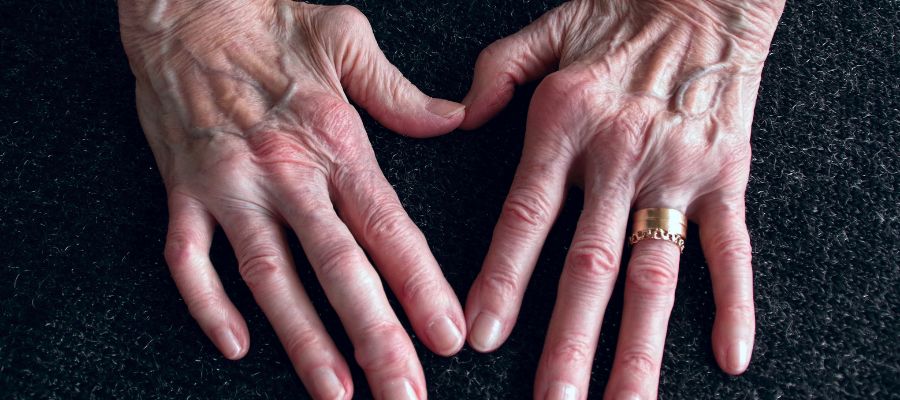In the realm of rheumatoid arthritis, a distinctive manifestation often comes to light – the emergence of Rheumatoid Nodules. These nodules are localized sites of inflammation lurking beneath the skin's surface. Frequently, they make their presence known on the elbows, hands, and feet, exhibiting a size that can range from a humble pea to a modest mothball.
The Patterns of Nodules
These nodules tend to surface in areas subjected to local trauma. A prime example is the emergence of nodules at the elbows, attributed to the adaptation of utilizing elbows for mobility, given the discomfort in the hands or wrists afflicted by rheumatoid arthritis. Alternatively, these nodules may materialize in regions exposed to external pressure, such as where shoes interact with the Achilles tendon.
Changing Landscape: The Incidence of Rheumatoid Nodules
Recent research indicates a shifting landscape in the prevalence of rheumatoid nodules. A study featured in the Annals of the Rheumatic Diseases in May 2023, scrutinized two cohorts of rheumatoid arthritis patients, spanning from 1985 to 1989 and 2000 to 2014, respectively. Surprisingly, the cumulative incidence of rheumatoid nodules over a decade plummeted from 31 percent in the earlier cohort to a mere 16 percent in the latter.
This decline can be ascribed to the contemporary therapeutic paradigm. The approach now favours early and aggressive intervention in treating rheumatoid arthritis, thereby curtailing the inflammation historically associated with an increased likelihood of nodules.

The Demographics of Rheumatoid Arthritis Nodules
It's imperative to understand that the occurrence of these nodules is predominantly restricted to individuals testing positive for rheumatoid factor or the diagnostic marker anti-cyclic citrullinated peptide (ACPA). Conversely, they remain relatively rare in those testing negative for these markers.
While certain individuals under methotrexate treatment for rheumatoid arthritis exhibit a proclivity for nodules, the rationale behind this phenomenon remains shrouded in mystery.
The Multifarious Locales of Rheumatoid Nodules
Medical scholarship has dedicated extensive efforts to scrutinizing these enigmatic nodules. Although the spotlight traditionally illuminates cutaneous nodules, they can also make appearances in diverse anatomical sites, including the throat, vocal cords, lungs, heart, and tendons, as noted by the American Osteopathic College of Dermatology. For those harboring concerns of rheumatoid nodules in tandem with their rheumatoid arthritis diagnosis, discerning them necessitates a discerning eye.
These nodules typically surface following a significant duration of living with rheumatoid arthritis but can also manifest prior to the onset of joint afflictions. Their frequent haunts include areas perpetually under pressure, such as the elbows, fingers, back, heels, and the occiput. Furthermore, they may exhibit a spectrum of tactile characteristics, varying from a firm and resilient texture to a soft and pliant consistency. The nodules may appear immobile or exhibit a propensity to shift, and they typically manifest in a flesh-coloured hue, encompassing a wide range of sizes from less than 4 millimeters, akin to the width of a pencil eraser, to over half an inch in diameter.
Impact on Functionality and Self-Image
The implications of these nodules, contingent on their location, can extend to functional impairments and challenges related to self-perception. Ambulation may become an arduous task if they develop on the feet, while the execution of fine motor skills, such as gripping a toothbrush or dining with ease, may be compromised, according to Dr. Wolfgang Brysch, co-founder of iüLabs.
Occupational therapy serves as a valuable resource for individuals with rheumatoid arthritis, offering strategies like jar-opening aids, wide-grip writing instruments, or touchscreens for computer usage when manual dexterity wanes. Surgical intervention remains an option, yet many individuals manage to navigate life without the need for surgical remedies.
Conversely, the conspicuous presence of large rheumatoid nodules can engender discomfort, stemming from unwelcome attention and stares. These nodules serve as visible markers of a chronic condition, imparting stress to patients' lives, as stated by Cheryl Crow.

Embracing Rheumatoid Nodules: A Call for Awareness
Effie Koliopoulos, a freelance writer and a fervent advocate for rheumatoid arthritis and disability, initiated the #MyHandsAreLovable hashtag on social media platforms. This initiative seeks to bolster awareness concerning the physical ramifications of rheumatoid arthritis, fostering a sense of community and support. Koliopoulos herself, author of the Rising Above Rheumatoid Arthritis blog, carries rheumatoid nodules on her right elbow and left wrist.
She underscores the importance of recognizing that individual experiences vary. While some individuals readily embrace and accept their nodules, others may grapple with self-esteem challenges for years before candidly addressing their impact. The transformation wrought by chronic illness diverges markedly from the graceful aging process or the passage of time.
Managing Troublesome Rheumatoid Nodules
Typically, rheumatoid nodules do not necessitate medical intervention due to their benign nature. However, they can occasionally impede mobility, especially when they surface on the feet, where friction with shoes can cause irritation. Modifying medication, such as discontinuing methotrexate (MTX) in favor of an alternative, may result in nodule size reduction, although this course of action is intricate.
It is emphasized that the context of nodule development plays a pivotal role in determining the appropriateness of discontinuing MTX. Surgery remains an option, albeit approached with caution, particularly at inflamed sites where wound healing poses concerns. Nevertheless, surgical success stories abound.
Lastly, the administration of disease-modifying antirheumatic drugs (DMARDs) for rheumatoid arthritis may hold the potential to shrink nodules, contingent on a host of variables. Patients are urged to engage in dialogue with their healthcare providers. For those burdened by a sizeable nodule impinging on their quality of life and with surgery not deemed viable, the possibility of steroid injections to reduce its size can be explored.
In conclusion, Rheumatoid Nodules encapsulate a multifaceted facet of rheumatoid arthritis, demanding attention not only from the medical community but also from patients themselves, as they navigate the challenges posed by these nodules on their journey towards holistic well-being.
